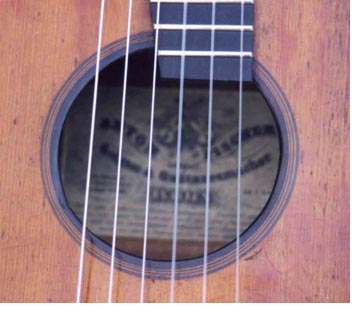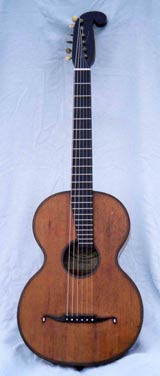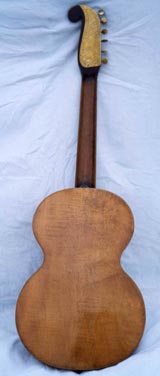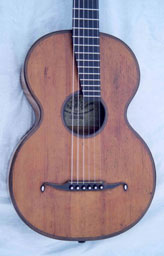Anonymous ("Anton Fischer" [sic])
 To find a period 19th-Century Viennese guitar that is fully-restored, playable and held privately (i.e. not in a museum) is extremely rare. After my 15+ years of study/teaching at the Academy for the Study of 19th Century Music (Vigevano, Italy), this is one of the finest examples I have seen.
To find a period 19th-Century Viennese guitar that is fully-restored, playable and held privately (i.e. not in a museum) is extremely rare. After my 15+ years of study/teaching at the Academy for the Study of 19th Century Music (Vigevano, Italy), this is one of the finest examples I have seen.
After purchasing this guitar in Vienna from a private collector, I had her restored in 2001 by the famed luthier, Urs Langenbacher in Füssen, Germany. Maestro Langenbacher is a graduate of the famed Luthiers School of Violin and Plucked Instruments in Mittenwald, Germany and in 2001 he won both the gold and silver medals at the international luthiers convention in Baveno, Italy, so needless to say, his workmanship is flawless. Langenbacher was proud enough of his work on this instrument that he documented this project for his portfolio.
The label reads that this is by Anton Fischer (1794-1879) but we believe the label is a forgery. Sadly it is impossible to know for sure who the builder is, though it is certainly of the early 19th-Century Viennesse school of builders and the workmanship is of an exceptionally high quality.
Contrary to most instruments of this period, THIS GUITAR HAS TUNING GEARS AS OPPOSED TO TUNING PEGS. This makes her not only more rare, but makes much more suited to modern players since tuning is considerably more precise.
This guitar, as with all the best early 19th-Century Viennese guitars, is similar to the form originally designed by Anton Georg Staufer and copied by his students, C.F. Martin (before he moved to the US), Fischer, Reisinger, etc.
In spite of the difficulty in documentation, this guitar is in tremendous condition and ready for concerts, recording, as a museum acquisition or as the focal point of a serious private collection of musical instruments. Note that it has the normal "dings" and minor scratches (that we will probably all have when we are nearly 200 years old!), but she is extremely solid and structurally sound.
Langenbacher replaced the fingerboard (including all frets), sealed several small cracks and he had the local goldsmith in Füssen copy and replace one key of the tuning gears which was broken. Langenbacher also refinished the entire instrument though (as is the tradition in violin restoration) he did not attempt to sand out any "dings" or scratches as this changes the thickness of the wood and can harm the original sound of the instrument. I have the documentation from Langenbacher which gives all details of his restoration.
I should add, as a performer, I would much prefer that this instrument go to a musician who will use it on stage.
If at all possible I would like to hand-deliver this instrument to the buyer to avoid any possible problems or risk in shipping.
 |
 |
 |
Instrument Specifications:
(all restorations were made by Urs Langenbach):
The label [AGAIN, WE FEEL THIS LABEL IS A FORGERY] (in German) reads: "Anton Fischer; Citizen [implying of Vienna]; Violin & Guitar Maker; In Vienna; [the following is the address information]: In the Graben, Trattnerschen Open Courtyard, Number 618, in the second courtyard; Maker of All Types of Violins, Violoncellos, Guitars and Harps. Strings of the Highest Quality as well as a Collection of the Best Instruments to be Found. Restorations of the Highest Quality also Available." [translation, mine]
Woods: table: light spruce [?], though the slight redish color of the original lacquer was maintained in restoration.
sides/back: flamed maple, slightly arched
fingerboard: ebony (new restored)
neck: unknown
(N.B. All following measurements given in metric)
scale length: 640 mm.
body length: 420
total overall length: 873
body width (at heel): 60
(at middle bout): 75
(at lower bout): 70
neck thickness
(at nut): 20.
(at 12th fret from table): 10.5
fingerboard width
(at nut): 40
(at 12th fret): 55
fingerboard length (nut to bridge): 610
tuning keys: mechanical-individually inset under brass plate (these were restored to original specifications by Langenbacher); keys: brass
suggested strings: gut (Labella) or medium gauge nylon
frets: Note: this instrument, as with most designed by Staufer after specifications by Legnani, goes up to the note d, rather than the traditional lower b of modern instruments. Essential for playing much of the music of the mid to late 19th Century.
neck/fingerboard: This neck/fingerboard (as designed by Legnani and originally constructed by Staufer) is "free floating," i.e. it is raised above the soundboard to allow totally free vibration of the soundboard and for better playability. The neck is in perfect condition. There is no warpage and no twisting of the neck.
This guitar comes with a modern case, as well as certification from the restorer which documents all restoration work.
Price: $18,000.oo, US, negotiable.
Contact: AeviaGroup@aol.com


